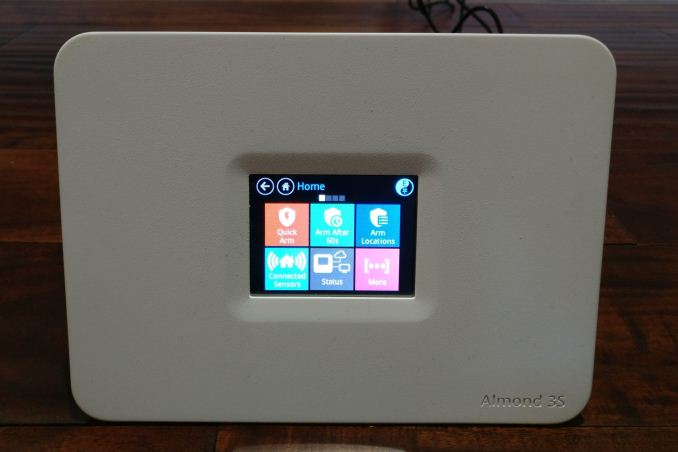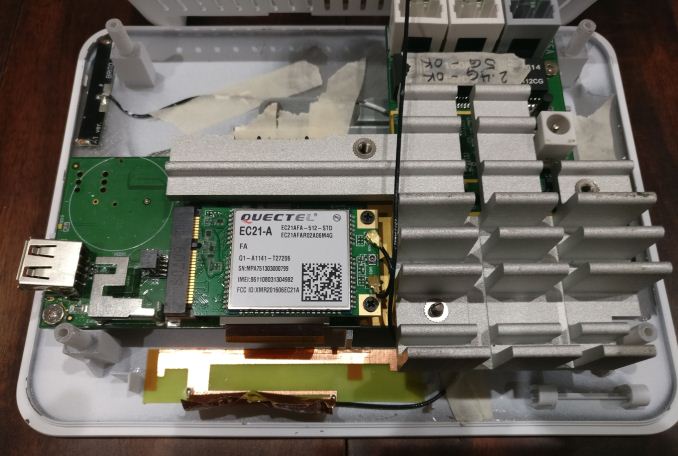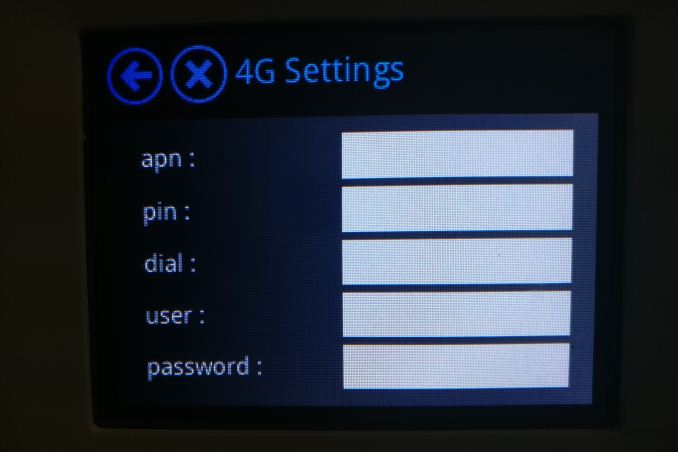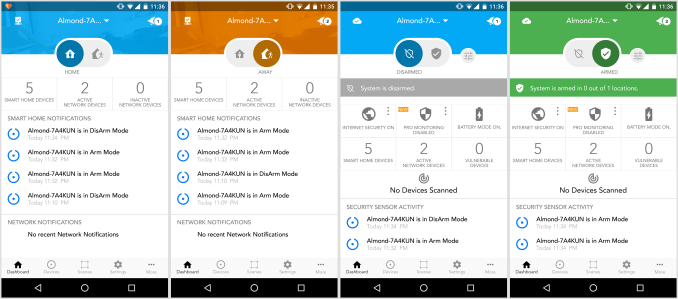Securifi Almond Guard DIY Home Security System: A Beta-Testing Report
by Ganesh T S on November 7, 2017 11:00 AM EST- Posted in
- IoT
- Networking
- Home Automation
- MediaTek
- Securifi
- Smart Home

Securifi's products have been covered before on AnandTech. They were the first consumer networking equipment vendor to successfully integrate a working IoT hub in a Wi-Fi router. By integrating ZigBee and Z-Wave support into their touchscreen routers, they managed to open up their addressable market and go up against more established players in the space. Today, Securifi is making public their plans to build upon their IoT platform. The Almond Guard, a DIY home security system, is being launched via a crowdfunding campaign. Starting with the Almond 3 platform, Securifi has added home security system features to both the hardware and software. An optional professional monitoring service will also be made available for $10/mo.
Over the last couple of months, I have been beta-testing one of the early Almond Guard units with alpha firmware and an alpha app. They were linked to a cloud server configured for evaluation purposes. In this piece, I will provide some thoughts on why home security is the killer app for consumer IoT before going into the details of the Almond Guard and my experience with it. A brief discussion of the competitive landscape for the product precedes the summary section.
- Background
- Home Security : A Market Ripe for Consumer IoT to Disrupt
- Almond Guard : The Hardware
- Almond Guard : Software Features
- Almond Guard : App & Cloud Back-end
- Competitive Landscape
- Miscellaneous Aspects and Concluding Remarks
Background
A couple of years ago, consumer IoT was heralded as the next big thing in the tech space. Unfortunately, it has not lived up to expectations. Industrial IoT, on the other hand, has made sure that the companies investing in it have some returns to show. However, consumer IoT / smart home devices is our focus in this article.
ZigBee, Z-Wave, and Bluetooth have emerged as the connectivity options in this area. Low-power Wi-Fi also has a strong presence. Most smart home devices come with a hub to bridge the communication network with an IP network. It is evident that integrating the radios into a router and avoiding the hub makes for a more unified solution. Securifi was the first vendor to bring such a product to the market. This integration has slowly started spreading to products from other manufacturers also. For example, Google's OnHub router has a 802.15.4 radio, but the firmware does not enable it. ASRock recently started supporting ZigBee peripherals with their X10 IoT router. Z-Wave has a wide install base, and, to our knowledge, the Securifi Almond routers are the only ones supporting both ZigBee and Z-Wave.
Consumer IoT has not taken off as planned because of the fragmented ecosystem. Each vendor wants the user to use their own app and cloud backend. Recent efforts such as Apple HomeKit, Google Home, and Amazon Alexa have a partial solution for this problem. Despite being forced to have some sort of integration with the above services, smart device vendors still opt to make most of their products entirely cloud-reliant. Cloud infrastructure needs maintenance. Hardware sales alone are not enough in the long run. The vendors have therefore been forced to partner with larger companies or turn to subscription-based 'smart home as a service' revenue model. The average consumer does not see much value in paying monthly fees to each IoT device vendor.
The 'smart home as a service' (SHaaS) model works in the general case only when tangible benefit is provided to the end user. Incumbent players who receive recurring revenue from the average household are ISPs and TV service providers (such as Comcast, and AT&T in the US), and home security / alarm service providers (such as ADT, Frontpoint Security, Livewatch Security etc.). Essentially, SHaaS has to be an add-on to such services. ISPs and TV service providers are harder to disrupt because of the capital expenditure involved in the consumer premises. This has allowed incumbents like Xfinity (with Xfinity Home) to make significant inroads with this approach. On the other side, ADT and other similar security / alarm service providers have also been making a killing in the market by adding home automation / smart home functionality as an expensive add-on to their offerings (with the package rates going up as more sensors are monitored). However, the expensive nature of this value addition has prevented smart home technology from becoming popular through this market segment.
Home Security : A Market Ripe for Consumer IoT to Disrupt
Traditional home security service vendors have kept the cost of adding / extending smart home functionality high. This has led to customers waiting for credible cheaper alternatives to emerge. Consumer IoT / smart home vendors, on the other hand, have supported most of the sensors and equipments used by home alarm / security vendors. Most of them have a cloud backend also. However, they have not had much traction in obtaining recurring revenue from their user base. Some IP camera vendors are notable exceptions - Nest, Ring, Canary, and a few others have managed to create a recurring revenue stream from a significant chunk of their user base.
Given these two aspects, it is surprising that the move of IoT / smart home vendors to the home security alarm market has taken so much time. Over the last few month we have seen a number of these vendors introduce offerings in this space
- Nest with Nest Secure (optional professional monitoring)
- Ring with Ring Protect (now in limbo, as ADT sues them) (optional professional monitoring)
- Canary (self-monitoring)
- Samsung SmartThings (optional ADT professional monitoring)
In addition, we also have traditional alarm services with a DIY twist such as SimpliSafe and Scout. Recently, Honeywell also launched their Smart Home Security product through a crowdfunding campaign.
Cybersecurity has also become important. Ransomware and other threats due to botnets / insecure IoT devices have become causes of concern for connected households. Home security is not only related to physical security, but, increasingly on the online front also. Vendors who can target both offer more value in this market.
Securifi is one of the very few vendors who can target both of these aspects. At CES earlier this year, they introduced a subscription-based internet security service. Other vendors in the space concentrated on the antivirus and antimalware aspects. At that time I wasn't sure whether the value offered was worth the subsription being charged. However, inclusion of home alarm motoring for a modest increase in premium would definitely deliver more value. Securifi is working towards that by introducing the Almond Guard.
Almond Guard : The Hardware
The Almond Guard hardware builds upon the Almond 3 platform. All the features available in the Almond 3
are retained in the Almond Guard. As a recap, the Securifi Almond 3 is an AC1200-class router with a dual-core MIPS-based Mediatek SoC (MT7621AT) as the network processor. The MT7602E and the ME7612E fulfil the 2x2:2 bgn and an+ac radio duties. It also has a SiLabs EM357 ZigBee radio on the board. Z-Wave is supported via a USB dongle. The system allows operation in a mesh configuration with multiple other Almond 3 units. The mesh firmware is something built specifically by Securifi unlike the Qualcomm Wi-F SON platform used as a base by the leading vendors in the mesh space.
The main differences between the Almond Guard (Almond 3S) and the Almond 3 in terms of hardware are:
- Different form factor to enable wall mounting similar to traditional alarm panels. The Almond 3S is closer to the Almond+ in appearance, rather than the Almond 3.
- Addition of a SIM slot to enable cellular backup (both for alarm data as well as traditional Internet communcation
- Addition of a battery to enable continued operation in case of a power failure
All the updates essentially replicate the functionality required by home alarm panels.
The picture of the updated PCB above shows the LTE module used for the cellular backup prominently. The Quectel LTE EC21 is a 10 Mbps / 5 Mbps LTE Cat 1 module optimized for M2M and IoT applications. Securifi indicated that the final version would sport a LTE module with specifications that would match the EC21 at the minimum.
Almond Guard : Software Features
The firmware in the Almond Guard has the updates necessary for the operation as a home alarm system. On the touchscreen, we have the shortcuts for arming - typical of traditional alarm systems. The other features are similar to that of the standard Almond 3 - the device can be configured in router, range extender, or access point mode. It can act as a home alarm system in any of those modes.
The 4G settings can also be configured via the touchscreen interface (assuming that the SIM slot is populated with a valid card).
The web interface is very basic (even for the Almond 3). Securifi expects most of the management to be done using the mobile app.
During our beta testing period, the web UI didn't have any particular enhancements for the home security system aspect. Given that the whole market has moved towards a mobile-first approach, we weren't surprised that the bulk of the efforts were being put towards honing the Almond app.
Almond Guard : App & Cloud Back-end
The Almond app has been redesigned to accommodate usage as a home alarm monitoring app. The redesigned home screen looks similar to one of the four screenshots below
Note that the mobile app can connect to the Almond Guard via the local network or through Securifi's cloud servers. In the local connection mode, the system can be set to Home and Away. Arming and disarming the system is available only in the cloud connection mode. This makes sense given that the system can inform the monitoring services only if it can connect to the cloud servers. The cloud connection mode also enables users to sign up for the Internet Security and/or Professional Monitoring services. The Almond Guard can also uses inferred information (using a Wi-Fi device availability-based scheme) to automatically arm or disarm the system.
The gallery below shows the updates made to the app to support the configuration of the home alarm system.
The initial setup of the system as well as association of sensors is similar to the Almond 3. However, the menu options for each sensor are different. Certain types such as the Almond Click and the motion and door sensors can be configured to sound the siren when activated in the Armed mode. An option is also available to send a CMS (central monitoring station) alert under such circumstances. Rules and scenes can be associated with the sensors, but, that aspect is the same as in other Almond hubs.
Once all the sensors are set up, users can proceed to the security set up. The sensors that need to be monitored for alarm purposes need to be selected. They can be further configured to send a push notification when activated (under different conditions - armed as well as disarmed). Entry and exit delays can be configured to allow sensors to remain in a triggered state before the disarm or arm command is received by the hub. The duration of the siren (after getting triggered in the armed state) can also be specified via the app.
A four-digit PIN is used to disable the alarm via the hub's touchscreen. A duress PIN and a safeword can also be configured. These are features that are available in traditional home security / alarm systems.
Competitive Landscape
The home security market is ripe for disruption, and a number of players have entered into the market recently. Consumer Reports recently updated their pick for the best DIY security system. Scout emerged as the best value with professional monitoring considered. Doing the equivalent math and specifications comparison shows that the Almond Guard comes out on top in every metric. The professional monitoring plan is $10/mo compared to $20/mo. for the equivalent Scout plan. On top of it, Almond provides cloud connectivity for free ($6/mo. for cellular backup if professional monitoring is not chosen), compared to Scout's $10/mo. On the hardware side, the Scout hub needs to be connected to the router, but, the Almond 3S is a router by itself.
In terms of initial hardware pricing, Securifi is selling the Almond 3S, 5x door / window sensors, 2x motion detectors, and 2x Peanut plugs (switchable power outlets) for $400 (early birds can get this for $300). An equivalent Scout package costs $372 up front (Scout doesn't have a Peanut Plug equivalent - the corresponding Almond Guard package after removing that would be $360 / $260).
Configuring a similar SimpliSafe bundle resulted in a total cost of $320 up front (compared to $360 / $260 for the Almond Guard). SimpliSafe simply doesn't have the home automation capabilities of the Almond 3S. Securifi also manages to undercut the professional monitoring services fee ($10 vs. $15/mo.).
The Nest Secure base package is not directly equivalent to any of the Almond Guard packages. However, a base price of $500 and professional monitoring adding $25 (with a 3-year contract) / $35/mo. makes it a very costly solution compared to the Almond Guard.
Ring Protect matches the Almond Guard in the $10/mo. professional monitoring aspect. A system equivalent to the $360 / $260 Almond Guard package has an upfront hardware cost of $329. This actually makes it a very close competitor to the Almond Guard. Unfortunately, Ring Protect is currently not being sold due to a legal tussle between ADT and Ring.
An ADT / SmartThings package similar to the Almond Guard's high-end package costs around $705 (compared to Securifi's $400 / $300 pricing). On top of that, the minimum monthly subscription for intrusion detection monitoring with ADT is $25/mo. This also makes little financial sense similar to the Nest Secure package.
The latest entrant to the home security market is Honeywell with its DIY solution using an intelligent camera in its base station. A package similar the Almond Guard's top configuration costs close to $700 (though, admittedly, the Honeywell base station is much more powerful with its IP camera integration). There is no professional monitoring service add-on, making a direct comparison to Securifi's offerings much more diifficult. Canary's offering is similar.
Thanks to being one of the early movers in this space, Securifi has also been at the forefront of integrating support for voice-based assistants such as Alexa and IoT services such as IFTTT. These are very popular features in the home automation space. That said, vendors like Ring, Nest, and even SimpliSafe, have their own IP cameras integrated in their alarm system package. Currently, Securifi has integrated support for a ZigBee-based 640x480 camera in the Almond Guard package (Nest Cam support is slated to come at a later date). The absence of a high-resolution video capture component in the Almond Guard offering could be considered as a drawback by some consumers.
Miscellaneous Aspects and Concluding Remarks
The hardware in the Almond 3S that I evaluated was feature-complete, though some features were not working in my beta unit as expected. The placement of some of the slots (such as the SIM card and the power inlet) were not final, and were difficult to access and use. The T-Mobile SIM that I tried didn't work, though the fault probably was on my side since I couldn't find a suitable SIM tray. The 2.4 GHz Wi-Fi SSID was also non-functional, but, that didn't affect the operation otherwise. All these aspects are bound to be fixed in the final unit.
Almond 3S Operating in Battery-only Mode
While Securifi also touts the mesh Wi-Fi feature, I wouldn't suggest power users to rely on it as the sole solution for their wireless network. The Almond Guard uses a Mediatek platform (the same as the Almond 3 launched in mid-2016). By the time the Almond Guard ships to retail in mid-2018, the platform would be quite out of date in the fast-moving Wi-Fi market space. It might serve the purpose for casual users / users satisfied with practical throughput rates of 50 - 100 Mbps in their internal wireless network. Our recommendation would be to use the Almond Guard as a smart hub, rather than a traditional router. Of course, one can associate Wi-Fi-based IoT devices with the Almond Guard's WLAN.
Consumer IoT features are functional in a local network, but, some of the nice features (such as push notifications) are cloud-only. I have been pushing Securifi to move more of these features to the local-only operation mode.
The Almond's app and web UI have a separate smart home section with the ZigBee and Z-Wave devices in it. I would also like Securifi to support Wi-Fi-based smart devices (such as LIFX bulbs and WeMo switches) in that section.
The base of supported smart home products should also be expanded (for example, some low-cost Z-Wave devices such as the Nortek GoControl thermostat are not fully supported). We would also like Securifi to support the 433 / 868 MHz sensors currently used in many of the incumbent wireless alarm systems.
Competition is mainly coming from a video background, but Securifi is currently not focusing on that aspect. It might be a deciding factor for some consumers. Personally, I believe dedicated IP camera solutions are the best bet. I would like them linked to a home security system as a second line of defence rather than recordings being stored all the time in the cloud. In any case, Securifi plans to have ZigBee-based cameras initially, and later expand to support other camera models. They do not plan extensive cloud storage options for video, since there are already better solutions in the market for the same.
A lot of the security features have already been ported to the latest firmware in the Almond 3 already available in the market. Consumers can already try them out, save for the battery backup and cellular connection.
Users installing their own SIM card can also opt to route data traffic through the cellular network. To our knowledge, this is the first router targeting home consumers that comes with a ready-to-use cellular backup connection.
Moving on to the home security subscriptions, the pricing is very disruptive at $10/mo. With this type of pricing (similar to the now-delayed Ring Protect), moving away from traditional alarm services like ADT or Livewatch Security is a no-brainer. The plans from the incumbents start at $25+, and consumers have absolutely no visibility into the operation of these alarm systems. Smart home features add heavily to the monthly subscription. Securifi's smart home features are already proven, and they don't require a subscription. The professional monitoring services severly undercut the incumbents. Assuming that works as advertised, I am sure power users will immediately move to these low-cost plans. Securifi could even sweeten the deal with their Internet-security solution as a modestly-priced add-on.
Another consumer-friendly aspect is that Securifi's monthly charges are fixed irrespective of the number of sensors used in the system. Many incumbent home alarm service vendors often hike up the monthly prices for just adding a couple of sensors.
At the business end of the article, it has to be said that the Almond Guard has its pros and cons. Securifi still has work to do in order to perfect the system. However, as a smart home hub, it really stands out for consumers wanting the right balance of local network flexibility and cloud-based features. I am currently using the Almond+ as my smart home hub, and I will be moving to the Almond Guard as my production smart home hub once the retail unit ships. I will be giving their Pro monitoring services a try for a couple of months before shifting to it from my current $30/mo. alarm service provider.
Source: Securifi

































15 Comments
View All Comments
Kigmatzomat - Tuesday, November 7, 2017 - link
There is also the VeraSecure. It combines the zwave/wifi/ZigBee/BT of the veraPlus with support for 400mhz security sensors, a cellular uplink and monitoring.I don't have a vera secure so I can't comment directly.
ganeshts - Tuesday, November 7, 2017 - link
Very interesting. Thanks for bringing this to my attention.I have been pushing Securifi to support Bluetooth and Wi-Fi devices in the smart home segment, and I am hoping this product will push them to do it :)
Other than the 400 MHz sensor and BT support, I also see in-built Z-Wave support. The Almond 3S requires a USB dongle for this purpose.
Only downside seems to be that monthly professional monitoring is $20/mo.
Samus - Tuesday, November 7, 2017 - link
I wish a modern solution was available that used my existing X10 310MHz sensors. My whole home is outfitted with them on doors, windows, and PIR motion. They work great but the hub is ancient and lacks any sort of internet-based communication (via a VOIP ATA, it is controlled through commands ala dialup, and notifies me by voice calls, not even text. It's pretty rudimentary.)Kigmatzomat - Wednesday, November 8, 2017 - link
Insteon supports X10, more or less. Look at an isy 994 controller or a homeseer controller with Insteon plug in to see if they work with your devices.Then you can either add new insteon or zwave devices to your set up. Or link up a real security panel
Kigmatzomat - Wednesday, November 8, 2017 - link
Another nit to pick, the vera3, released in 2012, was also a 4 port router/wifi access point as well a zwave HA controller. I am not sure if the Almond predates that.Kigmatzomat - Wednesday, November 8, 2017 - link
Have you looked at an HA/security combo? Most of the other non-cloud appliance HA controllers (ISY, Homeseer, Vera) will talk to one or more prosumer security panels (DSC, Elk, Honeywell).Monitoring on those panels can be had for $10 and they are more reliable than most HA controllers.
Kigmatzomat - Wednesday, November 8, 2017 - link
And as another note, all 3 of those have Alexa integration. I think they all talk to Google home as well, but that might be in beta or via an app.ddriver - Tuesday, November 7, 2017 - link
Needs moar bezel.Lord of the Bored - Monday, November 13, 2017 - link
For once, I agree with ddriver. That is a ridiculous amount of non-functional frame. They could use a larger display, add physical buttons, a few simple indicator lights, a pointless larson scanner... ANYTHING but the "endless sea of beige plastic" look they went with.mooninite - Tuesday, November 7, 2017 - link
If you're a "power user" I would recommend buying an Aeotec Gen 5 USB stick. It is a Z-Wave controller the size of a large flash drive. The device combined with any number of open-source controller apps (Domoticz, OpenHAB, Home Assistant) allow you to run your own home automation cloud... No subscription fees.